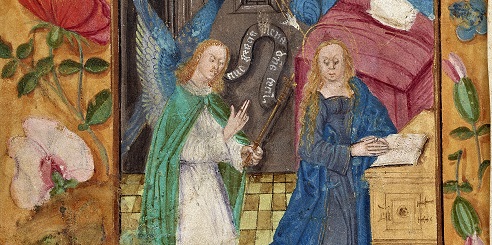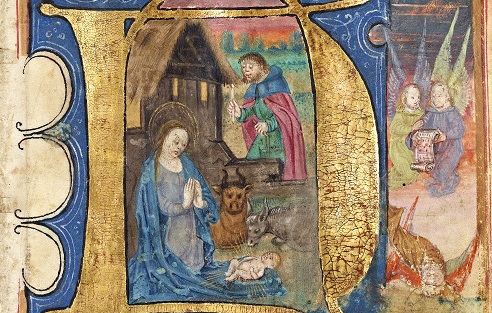A Dutch Book of Hours from the 15th Century
Private books of hours were the European bestseller of the 14th-16th centuries, especially among the aristocracy and urban élite. They typically began with a calendar, which listed saints’ days and other religious holidays, the most important of which were written in red – the so-called “red-letter days”.

AM 71 8vo, fols. 16v-17r. Two miniatures accompany the first prayer, matins, in the Hours of the Virgin. The one on the left depicts Annunciation when the archangel Gabriel appeared to the Virgin Mary and told her that she would conceive and become the mother of Jesus, the Son of God. The miniature is surrounded by a floral border. Click on the picture to see a larger version.
Private books of hours were the European bestseller of the 14th-16th centuries, especially among the aristocracy and urban élite. They typically began with a calendar, which listed saints’ days and other religious holidays, the most important of which were written in red – the so-called “red-letter days”. Following the calendar were texts used for religious devotion, such as litanies, excerpts from the gospels, and prayers. These could be written either in Latin or the vernacular – Middle Dutch, in the case of AM 71 8vo.
The highlight of AM 71 8vo is the opening devotion, known as the Hours of the Virgin. This liturgical devotion to the Virgin Mary is divided into eight ‘hours’ – eight times of day when a devotion should be read. Each of the hours is themed, telling the story of the birth of Christ and the coronation of the Madonna.
- Matins (Night) – The Annunciation
- Lauds (Dawn) – The Visitation
- Prime (First Hour) – The Nativity
- Terce (Third Hour) – The Shepherds
- Sext (Sixth Hour) – The Magi
- None (Ninth Hour) – The Circumcision
- Vespers (Evening) – The Flight to Egypt
- Compline (Night) – The Crowning of Mary
Matins
Although matins means ‘in the morning’ (Latin matutinus), the first of the hours was read in the middle of the night. According to the Rule of St. Benedict from AD 529, the Matin should be read in the eighth hour of the night, 02:00 a.m. After the Second Vatican Council (1962-65) the Matins were renamed ‘Office of Readings’ (officium lectionis), and can now be read at any time of the day.
Miniatures
Each of the new hours begins with an illuminated miniature featuring the Virgin Mary, representing the motif of each hour. The Annunciation belongs to the Matins, although in AM 71 8vo the opening hour also contains a miniature featuring the birth of Christ, which properly belongs to the Prime hour.
Text
There could be local variation in the text of the Hours of the Virgin, but most books of hours follow the same standard model. The Matins in AM 71 8vo are typical of Dutch books of hours, in a translation attributed to the fourteenth-century theologian Geert Groote.
The Matins open with two verses from the Psalms of David read as a call and response.
V: HEre du salste opdoen mijn lippen
Thou, O Lord, wilt open my lips
R: ende mijn mond sel voertkundigen dijn lof
And my mouth shall declare they praise
(Psalm 51:15)
V: God wilt dencken in mijn hulpe
Incline unto my aid, O God
R: Here mi te helpen haeste
O Lord, make haste to help me
(Psalm 70:2)
Following this, the Gloria Patri was read in unison.
Gloria si den vader ende den soen ende den heilighen gheest.
Glory be to the Father and the Son and the Holy Ghost.
Alst was inten beghinne ende nu ende altoes ende ewilic sonder eynde. Amen.
As it was in the beginning and now and always and forever without end. Amen.
The Invitatorium, or ‘Call to praise’, comes from Psalm 95 (listed as Psalm 94 in the Vulgate). The response to every verse is part of the Ave Maria.
V: INder eerlicheit der alre salichster ioncfrouwe maria
In the honor of the blessed Virgin Mary
R: Laet ons volhertelike blijscap hebben ten here
Let us have full-hearted joy for the Lord
COemt laet ons seer vuruechden ten here
Come let us rejoice unto our Lord
Laet ons iubilieren gode onsen heylgheuer
let us make joy to God our saviour
sijn aensichte laet ons te voren begripen mit belien
let us approach to his presence in confession
ende laet ons mit psalmen tot hem volhertelike blijscap hebben ten here
and in Psalms let us make joy unto him
Inder eerlicheit…
In the honour…
Want god is een groot heer
For God is a great Lord,
ende en groot coninc op alle die ghene die godlic sijn
and a great King above all gods
want die here en verdrijft niet sijn volc
because our Lord repelleth not his people
want in sinen handen sijn alle eynden van eertrike
for that in his hand are all the bounds of the earth
ende die hoecheit der berghen siet hi
and he beholdeth the heights of the mountains
Laet ons vol…
Let us full-…
A Dutch Prayer Book in Denmark?
Many manuscripts have travelled far from their place of origin, and AM 71 8vo is no exception. There are more Dutch and German prayer books in the Arnamagnæan Collection, many of which were bought at auction in 1726. The collection is sold at auction belonged to the civil servant Frederik Rostgaard (1671-1745) and contained thousands of printed books and manuscripts, including Greek and Hebrew Bibles, chronicles from Antiquity, Nordic laws, and more. Among Danish rarities were two printed books by Gotfred of Ghemen: Den Danske Riim-Krønicke (Danish Rhymed Chronicle, 1495) and Selandske Lov (Zealand Law, 1505).

AM 71 8vo, fol. 17r. On the right there is a historiated initial H with a depiction of the infant Christ in the manger. In the border, the angels of the Lord can be seen announcing the birth of the saviour to the shepherds watching their flocks, as described in the Gospel of St. Luke, 2.1-20. Click on the picture to see a larger version.
Contact
Anne Mette Hansen is an associate professor at the Arnamagnæan Collection.
Telephone: +45 3532 8713
amh@hum.ku.dk
Seán Vrieland is a PhD fellow at the Arnamagnæan Collection.
Telephone: +45 3533 7566
sfd989@hum.ku.dk
